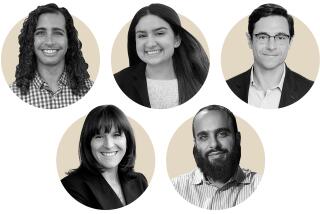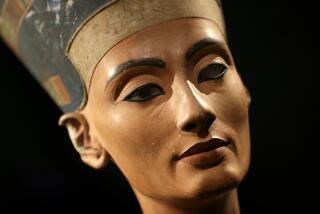The Veil: Meaning and Misconception
- Share via
Growing up in Cairo, Ola Hafez had wanted to wear the traditional veil. Her parents forbade it.
“They wanted to make sure I understood the commitment I was making,” she explained. Wearing a veil, they said, was not a rite of passage to be taken lightly only to be discarded later.
So it wasn’t until 15 years ago, when she was 20, that Hafez started wearing a veil as a way of maintaining the appropriate modesty prescribed by her religion and culture.
Hafez, a lecturer in the English department at Cairo University, was among speakers at a recent UCLA forum, “On Veiling and the Media,” sponsored by the Middle East Centers at UCLA in cooperation with New York and Columbia universities.
The forum’s purpose: to critique the Western media’s often-simplistic portrayals of the Arabic veil.
Among these portrayals is the stereotype of the veil as “the perfect symbol of [repressed] sexuality,” said Sondra Hale, adjunct professor of women’s studies at UCLA. That image and its counterpoint--the unveiled Muslim female as “a fallen, salacious woman . . . tells us more about Western values than about the Middle East,” Hale suggested.
The truth about the veil is quite different, conferees agreed.
* The veil is not a one-size-fits-all uniform, Hafez said. Rather, it may be anything from a scarf tied over the hair to a full-length robe, or chadour, which nearly covers both face and body.
* Worn primarily in the Arabic-speaking world, in part as protection against the often-harsh climate, the veil has waxed and waned in popularity. Over time, it has become associated with the region’s predominant religion, Islam.
* Wearing of the veil, however, is by no means universal practice among Muslim women, Hale said. The majority remain unveiled.
* Historically, the veil has also been worn by non-Muslims. Classical statues of Greek women often portray them wearing veils, said Afaf Marsot, professor of Middle Eastern history at UCLA, while Christian and Jewish women in the Middle East wore veils as protection against dust and sandstorms.
During her childhood in Egypt, Marsot added, poorer women wore veils while wealthier women preferred hats. Thus, wearing a veil had “an economic, rather than a religious, significance,” she said.
* The Koran, the Muslim holy book, does not require women to wear veils. On the contrary, said Marsot, “it says that during the Haj [the holy pilgrimage to Mecca], both men and women must face God, face to face.” The Koran also teaches that both men and women should dress modestly, with women hiding their cleavage--which the veil did before the invention of buttons.
Stigmatization of the veil in the West--where there is no stigma attached to other traditional head coverings, such as nuns’ habits or the elaborate wigs worn by English judges--has exacerbated an identity crisis among American Muslims wishing to avoid scorn, said Salam Al-Marayati.
Al-Marayati, director of the Muslim Public Affairs Council in Los Angeles, explained, “We are struggling to identify who we are. The lack of identity [fostered by the stigma] creates a vacuum. Stereotypes fill in that vacuum. So, we need to identify ourselves and not let others define us.” Muslims wear the veil, in part, to proclaim their religious and cultural identity, he said.
True, the veil has had a visible resurgence since the late ‘60s in much of the Muslim world. But, said Hafez, that resurgence stems less from a rising religious fundamentalism than from the increasing number of Muslim women joining the work force. As once-isolated homemakers joined a traditionally male work force, wearing a veil was “a compromise,” a way to maintain apartness and minimize sexual harassment.
In discussing the veil, Marsot cautioned, it is important to keep in mind that Muslims are one-fifth of the world’s population and “you can’t extrapolate from one country to another. Egypt is very different from Indonesia, the world’s largest Muslim country. And they are different from Morocco or Pakistan or Algeria.”
She pointed out that in countries bordering the Persian Gulf, including Saudi Arabia, Iran and Yemen, even non-Muslim women (including visitors) must almost always wear veils; those who do not risk antagonizing powerful religious as well as closely allied secular authorities.
Growing up in Iran, said UCLA graduate student Elham Gheytanchi, 25, she watched her friends protest having to wear a veil by “deliberately letting a little hair out.” Many Iranian women have begun fighting for equal social and professional rights, she added, but they are not yet ready to take on the more deeply entrenched issue of the veil.
More to Read
Sign up for Essential California
The most important California stories and recommendations in your inbox every morning.
You may occasionally receive promotional content from the Los Angeles Times.













